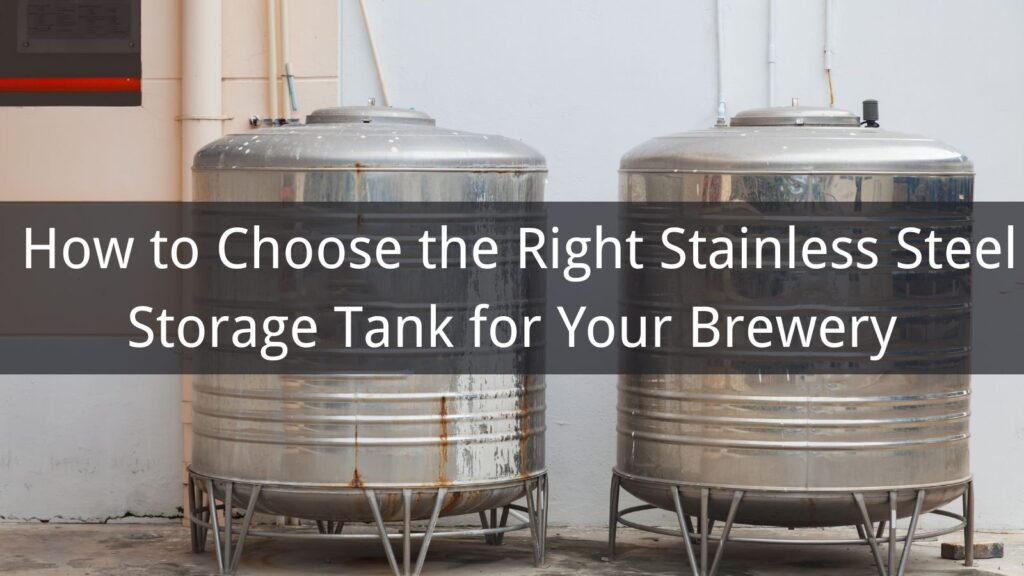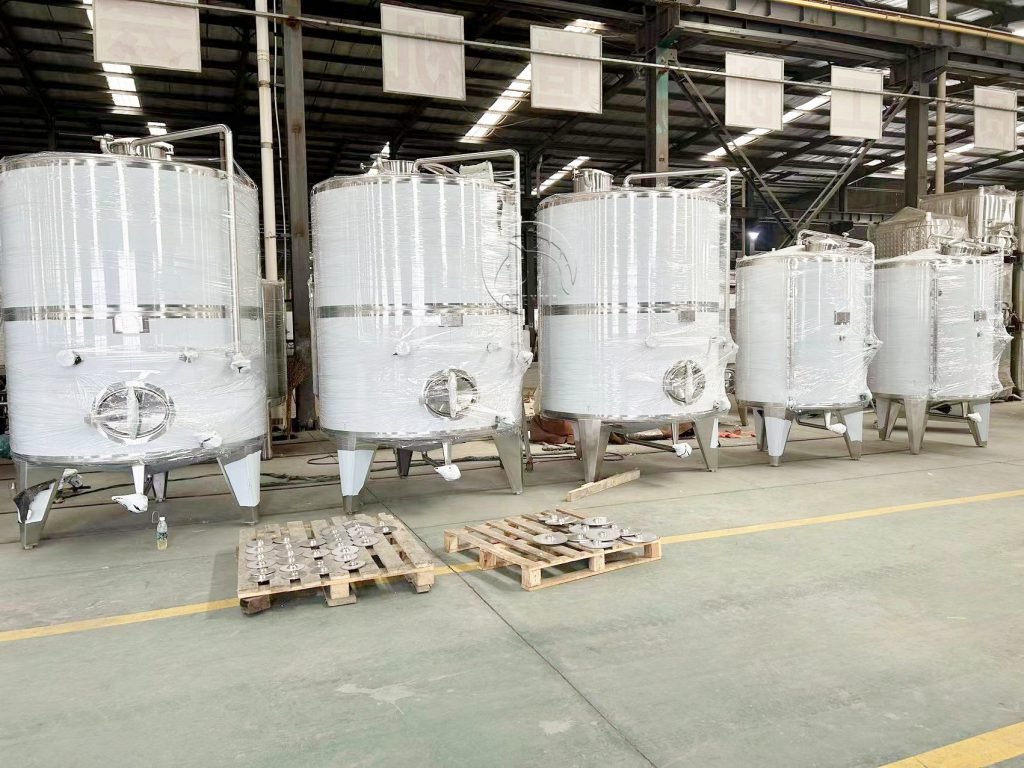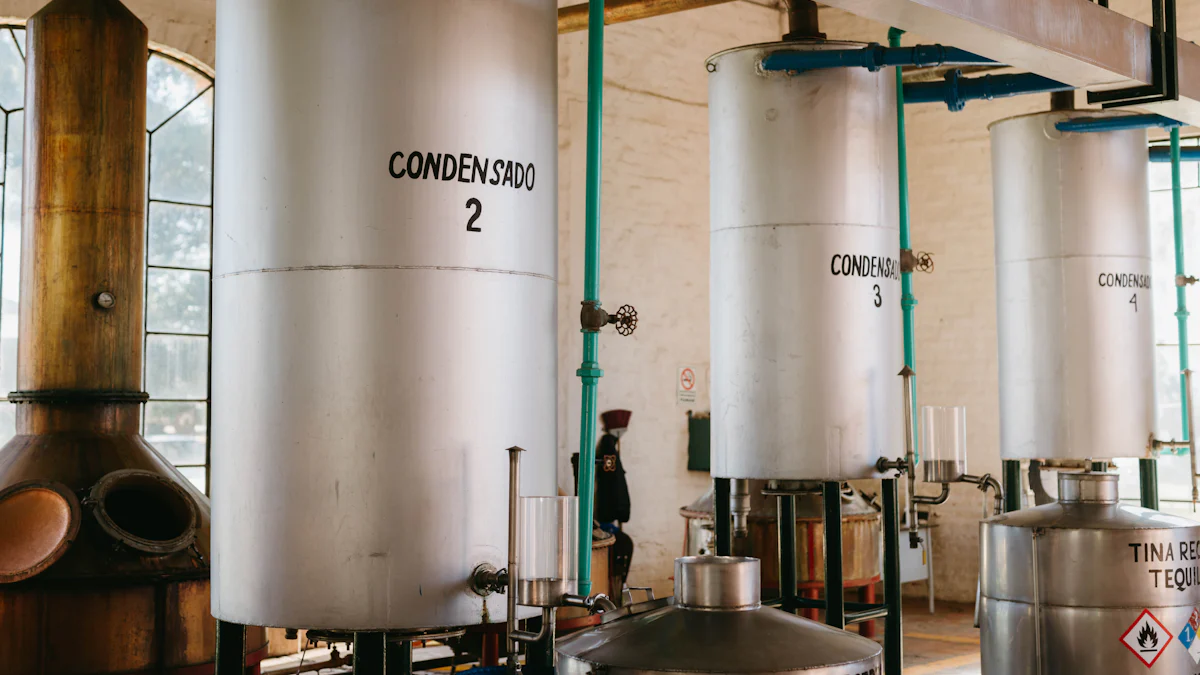
Choosing the right stainless steel storage tank is crucial for successful brewing operations. From fermentation to
aging, the quality of your tanks directly impacts product consistency, safety, and profitability. This comprehensive
guide explores essential factors for selecting optimal stainless steel storage tanks, covering material
specifications, design considerations, and maintenance requirements to help you make informed decisions for your
brewery.
Table of Contents
- The Critical Role of Stainless Steel Tanks in the Brewing Process
- Key Considerations for Selecting Stainless Steel Storage Tanks
- Select Stainless Steel Tank Types Based on the Brewing Process
- Stainless Steel Storage Tank Purchasing and Maintenance Recommendations
How to Choose the Right Stainless Steel Storage Tank for Your Brewing Process
The Critical Role of Stainless Steel Tanks in the Brewing Process
Stainless steel storage tanks serve as the backbone of modern brewing operations, providing essential containment
and processing capabilities throughout the production cycle. These vessels must maintain product integrity while
withstanding harsh cleaning chemicals, temperature fluctuations, and mechanical stresses inherent in commercial
brewing.
The brewing process demands tanks that offer superior corrosion resistance, excellent thermal conductivity, and
non-reactive surfaces that won’t affect flavor profiles. Stainless steel’s inherent properties make it the preferred
material for professional breweries worldwide, offering longevity and reliability that justify the initial
investment.
Modern brewing facilities rely on various tank configurations to optimize production efficiency. From ingredient
storage through final packaging, each stage requires specific tank characteristics to maintain quality and
consistency. Understanding these requirements is fundamental to selecting appropriate equipment for your operation.
Key Considerations for Selecting Stainless Steel Storage Tanks
Material Grade and Corrosion Resistance
The foundation of any quality brewing tank begins with proper material selection. Food-grade stainless steel,
particularly 304 and 316L grades, provides the corrosion resistance and sanitary properties essential for brewing
applications. Grade 316L offers superior resistance to chloride-based sanitizers commonly used in brewery cleaning
protocols.
Surface finish quality significantly impacts cleaning efficiency and microbial control. Interior surfaces should
maintain a smooth, polished finish with minimal surface roughness to prevent bacterial harboring and facilitate
thorough cleaning. External finishes can vary based on environmental conditions and aesthetic preferences.
| Steel Grade | Composition | Best Applications | Corrosion Resistance |
|---|---|---|---|
| 304 | 18% Chromium, 8% Nickel | General brewing, storage tanks | Good |
| 316L | 18% Chromium, 10% Nickel, 2% Molybdenum | Fermentation, high-acid environments | Excellent |
Tank Capacity and Shape Design
Capacity determination requires careful analysis of production volumes, batch sizes, and operational flexibility
needs. Oversized tanks can lead to inefficient use of space and increased cleaning costs, while undersized vessels
create production bottlenecks and limit growth potential.
Tank geometry affects mixing efficiency, heat transfer, and cleaning effectiveness. Cylindrical designs with
conical bottoms facilitate complete drainage and yeast harvesting, while rectangular tanks may offer space
efficiency advantages in certain layouts. Consider future expansion plans when sizing your initial tank inventory.
Height-to-diameter ratios impact hydrostatic pressure and mixing characteristics. Taller, narrower tanks provide
better CO2 retention and pressure control, while shorter, wider vessels offer easier access for maintenance and
cleaning operations.
Insulation and Cooling System Configuration
Temperature control capabilities are critical for maintaining product quality and process efficiency. Insulation
materials should provide excellent thermal performance while remaining compatible with cleaning chemicals and
procedures. Polyurethane foam insulation offers superior performance but requires proper vapor barriers to prevent
moisture infiltration.
Cooling system design affects both initial costs and operational efficiency. Wine fermentation tanks often utilize glycol cooling
jackets, while larger storage vessels may benefit from direct expansion refrigeration systems. Consider energy
efficiency, maintenance requirements, and temperature control precision when selecting cooling configurations.
Zone cooling capabilities allow for temperature gradients within larger tanks, enabling specialized processing
techniques and improved product consistency. Multiple cooling circuits provide redundancy and operational
flexibility for critical applications.
Sealing Performance and Pressure Tolerance
Proper sealing prevents contamination and maintains atmospheric control within tanks. Gasket materials must
withstand cleaning chemicals, temperature cycling, and mechanical stress while maintaining food-grade compliance.
EPDM and silicone gaskets offer excellent performance in most brewing applications.
Pressure ratings should accommodate both positive and vacuum conditions encountered during normal operations.
Fermentation generates significant pressure that must be safely managed through relief systems and structural
design. Consider maximum operating pressures for carbonation and cleaning procedures.
Manway design affects access for cleaning, inspection, and maintenance. Larger openings facilitate thorough
cleaning but may compromise structural integrity. Balance accessibility needs with pressure requirements and space
constraints when specifying manway configurations.
Ease of Cleaning and CIP Compatibility
Clean-in-place (CIP) systems require tanks designed for optimal cleaning solution circulation and drainage.
Interior surface geometry should eliminate dead zones where cleaning solutions cannot reach effectively. Smooth
transitions, adequate slope angles, and strategic spray ball placement ensure thorough cleaning coverage.
Drainage systems must achieve complete liquid removal to prevent bacterial growth and contamination. Tank bottoms
should slope toward drain outlets with sufficient angle to overcome surface tension. Consider heated CIP systems for
applications requiring enhanced cleaning performance.
Sampling ports and instrumentation connections require careful design to maintain sanitary conditions while
providing necessary process monitoring capabilities. Tri-clamp fittings offer reliable sealing and easy maintenance
compared to threaded connections.
Select Stainless Steel Tank Types Based on the Brewing Process

Raw Material and Wort Storage Tanks
Raw material storage requires tanks optimized for ingredient preservation and handling. Grain storage tanks should
protect against moisture and pests while allowing for easy discharge and inventory management. Liquid ingredient
tanks need appropriate agitation systems to prevent settling and maintain consistency.
Wort storage tanks bridge the gap between brewing and fermentation, requiring temperature control and contamination
prevention. These vessels must maintain wort quality while providing flexible scheduling between production stages.
Consider oxygen exposure limitations and time constraints when sizing wort storage capacity.
Hot liquid storage demands enhanced insulation and safety features to protect personnel and maintain temperatures.
Vapor recovery systems may be necessary to capture volatile compounds and improve efficiency.
Fermentation Tanks
Fermentation tanks represent the heart of the brewing
process, requiring precise temperature control, pressure management, and contamination prevention. Conical bottom
designs facilitate yeast harvesting and trub removal, while cooling systems maintain optimal fermentation
temperatures.
Tank sizing should accommodate foam generation and CO2 evolution during active fermentation. Headspace requirements
vary by product type and yeast characteristics. Consider scalability and batch consistency when selecting
fermentation vessel configurations.
Instrumentation needs include temperature monitoring, pressure measurement, and sample collection capabilities.
Modern fermentation tanks increasingly incorporate automated controls and data logging for improved process
consistency and quality assurance.
| Tank Type | Primary Function | Key Features | Capacity Range |
|---|---|---|---|
| Fermentation | Primary/Secondary fermentation | Conical bottom, cooling jacket | 100L – 10,000L+ |
| Bright Tank | Conditioning, carbonation | Pressure vessel, sample ports | 200L – 5,000L |
| Storage | Finished product holding | Insulation, CIP capabilities | 500L – 20,000L+ |
Aging and Conditioning Tanks
Aging processes require tanks that maintain stable conditions over extended periods. Temperature stability, minimal
oxygen exposure, and contamination prevention are critical for developing desired flavor profiles. Insulation and
environmental controls become increasingly important for longer aging cycles.
Conditioning tanks prepare products for packaging by achieving final carbonation levels and clarity. These vessels
often operate under pressure and require precise control systems for consistent results. Consider accessibility for
sampling and quality testing throughout the conditioning process.
Variable capacity wine tanks offer flexibility for
varying batch sizes and minimize headspace exposure during aging. These systems adapt to different product volumes
while maintaining optimal storage conditions.
Yeast Recovery and Cleaning Solution Storage
Yeast recovery systems require specialized tanks designed for cell separation and storage. These vessels must
maintain yeast viability while preventing contamination and facilitating easy transfer operations. Consider
temperature control and agitation capabilities for optimal yeast management.
Cleaning solution storage tanks house CIP chemicals and rinse water between cleaning cycles. These tanks must
resist corrosion from concentrated cleaning agents while maintaining solution integrity. Proper labeling and safety
features prevent accidental contamination or exposure.
Waste storage and recovery systems capture and process brewery byproducts for disposal or beneficial use. These
tanks may require specialized coatings or materials to handle acidic or alkaline waste streams.
Intelligent and Automated Configuration Trends
Modern brewing operations increasingly incorporate automated controls and monitoring systems into tank designs.
Smart sensors provide real-time data on temperature, pressure, level, and other critical parameters. This
information enables proactive maintenance and optimal process control.
Integration with brewery management systems allows for centralized monitoring and control of multiple tanks
simultaneously. Data logging capabilities support quality assurance programs and regulatory compliance requirements.
Automated cleaning systems reduce labor costs and improve consistency while ensuring thorough sanitation. These
systems require careful integration with tank design to achieve optimal performance and reliability.
Stainless Steel Storage Tank Purchasing and Maintenance Recommendations
Choosing a Qualified, Professional Manufacturer
Selecting an experienced manufacturer is crucial for obtaining tanks that meet your specific requirements and
quality standards. Shandong Chenma Machinery Co., Ltd. brings over two decades of experience in
designing and manufacturing stainless steel tanks for the brewing industry. Our 20,000 m² production facility houses
state-of-the-art equipment capable of producing even the most technically demanding designs.
Look for manufacturers with appropriate certifications and quality management systems. Chenma has achieved
ISO9001-2005 quality system certification, ISO14001-2015 environmental management system certification,
OHSAS18001-2007 occupational health management system certification, and EU CE certification, demonstrating our
commitment to quality and safety.
Experience in your specific industry segment ensures understanding of unique requirements and challenges. Our focus
on alcohol production, including cider fermenters and wine
equipment, allows us to adapt products according to customer needs and industry best practices.
Customized Design Based on Process Requirements
Standard tank configurations may not address all operational needs, making customization capabilities essential.
Our talented engineers adapt tanks to unique situations daily, modifying products from our catalog or engineering
completely custom solutions upon client request.
Process integration considerations include piping connections, instrumentation requirements, and spatial
constraints. Custom designs can optimize tank placement, improve workflow efficiency, and enhance safety features
specific to your facility layout.
Future expansion plans should influence initial design decisions to ensure compatibility with planned upgrades and
capacity increases. Modular designs and standardized connections facilitate future modifications and additions.
Clearly Define After-Sales Service and Warranty Terms
Comprehensive warranty coverage protects your investment and ensures prompt resolution of any manufacturing
defects. Establish clear terms for warranty duration, coverage limitations, and response times for service requests.
Technical support availability becomes critical during startup and troubleshooting situations. Ensure your
manufacturer provides knowledgeable support staff and comprehensive documentation for proper operation and
maintenance procedures.
Spare parts availability and lead times affect long-term operational costs and downtime risks. Establish parts
stocking agreements and emergency support procedures to minimize production interruptions.
Develop a Reasonable Daily Inspection and Maintenance Plan
Preventive maintenance programs extend tank life and prevent costly failures. Develop inspection schedules that
address gasket condition, surface integrity, instrumentation calibration, and safety system functionality. Regular
maintenance reduces long-term costs and ensures consistent performance.
Documentation requirements support regulatory compliance and warranty claims. Maintain detailed records of
inspections, maintenance activities, and any modifications or repairs performed on tanks.
Training programs ensure operators understand proper procedures and recognize potential problems before they become
critical. Invest in comprehensive training for all personnel who interact with tank systems.
Emphasis on Accessory Compatibility and Long-Term Supply
Standardized fittings and connections simplify maintenance and reduce inventory requirements. Tri-clamp fittings,
standard port sizes, and common gasket materials improve operational efficiency and reduce costs.
Component obsolescence planning ensures continued availability of critical parts throughout the tank’s service
life. Work with manufacturers who maintain long-term parts availability and can provide upgrade paths for aging
components.
Compatibility with existing brewery systems prevents integration problems and reduces installation costs. Consider
pipe sizing, electrical requirements, and control system compatibility when specifying new tanks.
For expert guidance on selecting the perfect stainless steel storage tanks for your brewing operation, contact
Shandong Chenma Machinery Co., Ltd. Our experienced team can help you design a custom solution that
meets your specific requirements and budget. Visit sdchenma.com to learn more
about our comprehensive range of brewing equipment, or reach out directly at admin@sdchenma.com or
WhatsApp +86 18063421809.
Our commitment to quality, innovation, and customer satisfaction makes us the ideal partner for your brewing
equipment needs. From initial consultation through installation and ongoing support, Chenma provides the expertise
and reliability you need for successful brewing operations.



